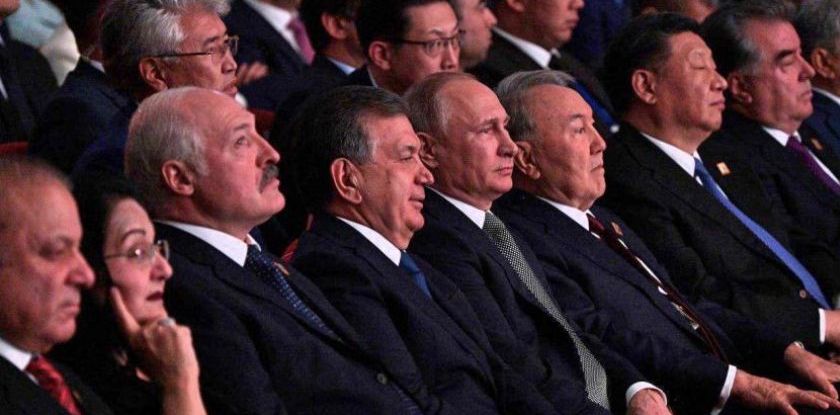The annual SCO summit took place in Astana on June 8-9. At the summit, India and Pakistan became full members of the organization. Thus, the Shanghai “six” has now transformed into the Shanghai “eight” whose geographic scope amounts to 70% of the Eurasian continent. So, now it is fair to say that about half of the Earth population lives in the SCO countries.
Note that, given the post-Cold war international relationships imbalance, the Shanghai Cooperation Organization was founded in 1996 as the “Shanghai five” (China, Russia, Kazakhstan, Tadzhikistan, Kirgizia) for the purpose of resolving border disputes. In 2001, the “five” was joined by Uzbekistan thus obtaining its current title. At that point, the members of the “six” made a decision to employ the instruments of the multiway cooperation to ensure their own and regional safety and to unify their attempts to fight terrorism, separatism, and extremism. And now, with India and Pakistan joining the group, we are talking about the “eight”.

Apparently, if Iran with its substantial energy, scientific, and industrial potential receives the same status in the organization, it will improve the SCO’s performance even more turning the group into a “full-featured civilizational” structure. Then, the idea of the civilizational union between Russia, China, and Iran (RIC) in the framework of a single regional or international organization may, finally, find a way to materialize in the framework of the SCO.
During the Astana summit, the subject had been brought up more than once. On the sidelines, they even said that the year 2018 may be the date when Iran joins the organization. (Note that Iran submitted the application in 2008).
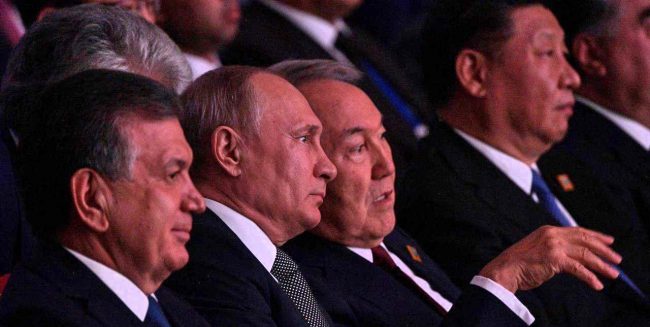
This topic deserves a detailed consideration because it is precisely the situation with Iran’s SCO membership that lifts the curtain over the organizational inner conflicts that may be invisible thanks to the laudable releases on the SCO achievements. It may be yet another declaration on the consolidated ways to sustain the SCO future development, a convention on fighting extremism, statements on the united struggle with terrorism, etc.
We must acknowledge that, today, Russia is the only SCO member lobbying the Iranian membership in the organization. At the Astana summit, President Putin said, “Iran is completely prepared to become a member of the organization and, after signing the nuclear treaty, there is no cause for denying its membership”.
Kazakhstan and Uzbekistan hold a different opinion. They fear that, with Iran as a member, the SCO will become a two-level structure – the RIC and the others – so, their role and weight in the organization will be seriously undermined.
Kyrgyzstan is taking a wait-and-see approach that, of course, could be easily changed if the country was promised some material dividends.
Tadzhikistan’s position is a more complex one. On the one hand, officially, it claims to be a lobbyist of Iran’s membership in the organization. On the other hand, considering Tadzhikistan’s inner conflict that resulted in exiling the Islamic Renaissance Party both from power and the country, Iran as one of the guarantors of the conflict resolution supports the IRP. Tadzhikistan considers it an interference in their domestic matters and has completely forgotten the actual role that Iran had played in the peaceful resolution of the conflict.
China’s view of the matter is not one-sided as well. On the one hand, the Chinese-Iranian economic relations are developing at high speed. In the political sphere, however, China does not like to rush. So, the optimism regarding the possibility of Iran joining the SCO in 2018 is not shared by everyone.
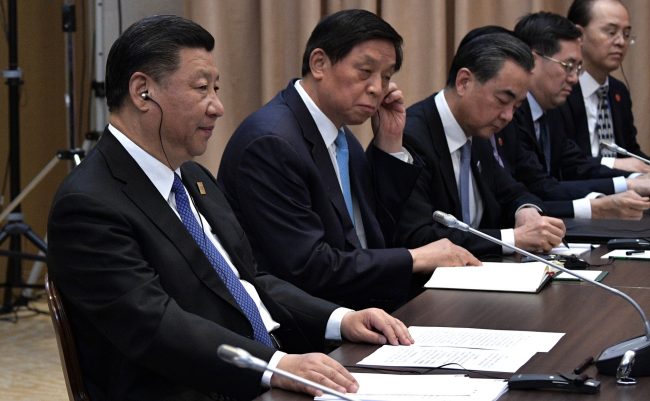
It has been clear for some time that Beijing uses its SCO influence to promote exclusively its own interests in the Central Asian region. It is driven not by the idea of the Eurasian unity but by the national egoism. Note that, in the course of the SCO existence, not one single multi-sided project has been realized and the SCO bank that could finance such projects has not been founded yet.
Beijing needs the trust of the Central Asian elites to resolve the matters of construction and security of the hydrocarbons transportation routes, the trust of Afghanistan – to ensure the development of the desirable fields including the Aynak copper deposit. For that purpose, China pays a special attention to constructing a sophisticated transport and communication system in the region including a possibility to access the Persian Gulf. Today, China has already included the Central Asian national economies in its own economic development.
Russia is trying to preserve its role in Central Asia via the EAEU and SCTO. However, Moscow’s economic policy in the region has proven to be inconsistent. It is usually accompanied by huge PR-campaigns at the start of a new project that turns out to be not completely prepared and not having enough resources for the implementation and effective management decision.
In truth, Moscow can successfully perform two tasks – writing off the state debt and using the migration policy to solve tactic problems. In the SCTO framework, only Russia has the modern military capacities. Besides, the other members of the organization are unenthusiastic about the idea of carrying out military operations in the post-Soviet grounds together with Moscow.
One of the most important negative factors in the Chinese-Russian relationships is the growing inequality of the partners. In fact, after the Crimean events, Russia’s dependency on China has grown even more. (We can conclude this from the mere fact that Russia had attempted to receive Chinese loans to finance Nord Stream 2). Now, apart from fearing for its territorial unity, Russia sees China as a credible threat that may squeeze it out of the territory of Russia’s strategic interests causing it to lose the economic control over the realization of its strategic energy projects.
Apart from that, there is the existing glut in the energy market which gives China the right to dictate the terms of the gas cooperation. Such a tactics elicited itself in the case of Turkmenistan and one may suppose that, in regard to the Russian partners, Beijing will employ the same methods (perhaps with small alterations).
At that, it is evident that China, first of all, desires to avoid coordinating its actions with a third party. In the framework of the Silk Road Economic Belt (SREB), the projects are being realized exclusively on the two-side basis. Therefore, on the part of the Russian state officials, it is naïve to expect a possible association of the EAEU and SREB for the purpose of creating a sustainable geopolitical union.
As we know, the EAEU is operating on the basis of the coordinated macroeconomic and financial policies. China, however, finances certain SREB projects on the two-side basis and exclusively in the form of loans. It is difficult to imagine the attempts to adopt the coordinated policy in the framework of the EAEU when China, not being a part of the organization, owns its members’ debts. At that, one of the key feature of the Chinese financing is the fact that, in general, the credits are disbursed by the Chinese companies with a small part left for the national agencies controlled by the elites of the state where China is implementing the project. In fact, the Chinese loans are used for financing the Chinese subcontractors but the liabilities are placed on the national budgets. It is a well-known Chinese practice.
I agree with the experts who believe that China is not at all interested in limiting its activities in the EAEU countries. At that, it is clear that China will continue promoting the “association” and “trust” slogans, holding the multi-level propaganda events aimed to support the illusion (including the employment of the experts from the EAEU countries on the implicit monetary basis).
The Chinese-Indian relations remain no less complex. The fact that, after the EU, China has become the second biggest Indian trade partner is a positive thing, of course. However, the perspectives of the two-side economic development are darkened by a plethora of political problems. At that, the Chinese economy is five times bigger than the Indian economy (China’s GDP amounts to $11064 bln, China’s value of foreign trade amounts to $3685 bln. For India, the indexes are $2088 bln and $ 623, respectively). Besides that, China has a much bigger military potential while being a member of the UN Security Council.
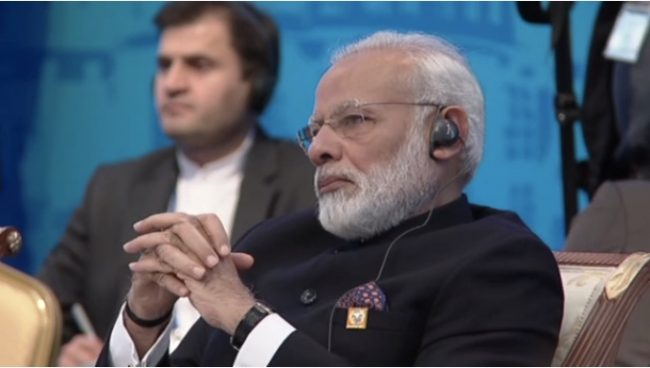
The tension due to the 1962 border issue is still very much alive, too. The matter of the tight connections between China and Pakistan including China’s support of Pakistan on the Kashmiri problem is also a factor. Besides, India is worried about China’s widening its military ties with the Indian neighbor and China’s marine activities from Myanmar through Bangladesh, Sri Lanka, Pakistan to Djibouti.
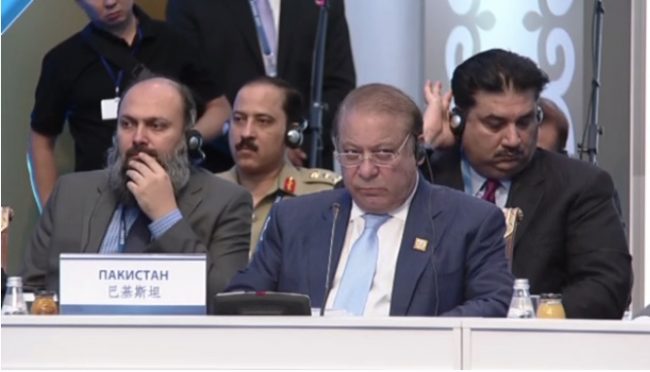
It is also indicative that, in 2016, China (approximately at the time of the SCO summit in Tashkent) blocked India’s application to join the Nuclear Suppliers Group. Therefore, in the words spoken by an Indian expert during the Astana summit, “the India-China relations, especially lately, have been a bit complicated”.
We must also discuss the Russia-India relations, at least, briefly. Despite the theoretically huge potential, the annual total trade between the countries amounts to less than $10 bln. In fact, the Russian-Indian cooperation is limited to two, albeit important, but not big enough for the strategic partnership spheres. First, it is the cooperation in the sphere of the peaceful usage of the nuclear power and, second, the in the sphere of the purchase and sale of weaponry. However, there is a problem with it as well. Given the strategic cooperation between India and the US where India is gaining the status of a “biggest US military security partner”, the Russian-Indian military partnership may turn out to have clearly defined limits.
Nonetheless, we cannot univocally say that the SCO will never become an authoritative international mechanism of cooperation. One way or another, we are now observing that the existing international order led by the US has clearly weakened due to the pressure of the numerous internal and external problems.
Despite the obvious differences between India, Iran, China, and Russia, all the states have serious ambitions and will try to gain a much bigger influence on the international arena.
Russia, Iran, China, and India do not belong to the so called “Western bloc”, they display a relatively similar negative attitude to the US one-sided approach, they are on the same page in their understanding of the necessity to create a multi-polar world order and a polycentric system of the international relations. However, analyzing the perspectives of their cooperation both in the SCO framework and on the two-side basis, we must remember that these countries have never demonstrated the ability to achieve consensus that could serve as an alternative to the West, to the US hegemonic policy, and to the one-polar world.
At that, note that all the four states, despite their rhetoric, continue to perceive the US as the main strategic orienting point for their international policies. It means that, in Moscow, New Delhi, Beijing, and Tehran, they acknowledge the central role of the US. Therefore, their preferences in how to communicate with Washington, will directly (and, mainly, negatively) influence the perspectives of the political coordination with each other.
Apart from that, sharing the general negative attitude to the exiting international world order, they differ in their understanding of its future development. For example, Russia, India, and Iran see themselves as equal centers of the multi-polar world. In Beijing, however, they see the multi-polar order very differently, through the prism of the Chinese-US relations (the only global relations that matter), in other words, on the basis of the “bi-polar and +” principle. Based on this, China continues interacting with the US in the three fields simultaneously – cooperation, competition, confrontation – with the emphasis on the first one.
Thus, the discrepancy between the SCO rhetoric on the common interests and challenges and the objectively existing mistrust and conflicts of interests between Moscow, Tehran, Beijing, and New Delhi do not give much cause for optimism.
Nonetheless, the suggestion made in Astana on reviving the activity of the Afghanistan contact team may become the very thing to master the effectiveness of the real cooperation in the SCO framework. Throughout the SCO’s existence, Afghanistan has been one of the main sources of exporting terrorism, separatism, and extremism to the members of the organization that was, indeed, created to neutralize these very threats. So, why not try and master the effective international cooperation in solving the Afghan problem?
On the author. Andrey Medvedev is a Russian political expert, COO of the PolitKontakt noncommercial organization.

